1st DEC 1965 BORDER SECURITY FORCE
Border Security Force
From Wikipedia, the free encyclopedia
| Border Security Force सीमा सुरक्षा बल | |
|---|---|
| Abbreviation | BSF सी सु ब |

Emblem of the Border Security Force
| |
| Motto | जीवन पर्यंत कतृव्यं[1] |
| Agency overview | |
| Formed | 1 December, 1965 |
| Legal personality | Non government: Central Armed Police Forces |
| Jurisdictional structure | |
| Federal agency | IN |
| Governing body | Ministry of Home Affairs (India) |
| Constituting instrument | Border Security Force Act, 1972 |
| General nature |
|
| Specialist jurisdictions |
|
| Operational structure | |
| Headquarters | New Delhi, India |
| Minister responsible | Rajnath Singh, Minister of Home Affairs |
| Agency executive | Devendra Kumar Pathak, IPS[1],Director General, BSF |
| Parent agency | Ministry of Home Affairs |
| Facilities | |
| Boats | 100+ |
| Planes | 22 Aircraft (as of 2009) |
| Website | |
| bsf.nic.in | |
The Border Security Force (BSF) (Hindi: सीमा सुरक्षा बल) is the primary Border police force of India. It is one of the five Central Armed Police Forces of the Union of India, it was raised in the wake of the 1965 War on 1 December 1965, "for ensuring the security of the borders of India and for matters connected there with".[2][3] It is a Central Armed Police Force charged with guarding India's land border during peace time and preventing transnational crime. It is a Union Government Agency under the administrative control of Ministry of Home Affairs. The BSF has its own cadre of officers but its head, designated as a Director-General(DG), since its raising has been an officer from the Indian Police Service. It is an Armed Force of the Union of India tasked with various assignments from time to time.[3] The BSF has grown exponentially from a few battalions in 1965, to 186 battalions with strength of 2.4 lakh personnel including an expanding air wing, marine wing, artillery regiments, and commando units.[4] It currently stands as the world's largest border guarding force. BSF has been termed as the First Wall of Defence of Indian Territories.[5]
Contents
[hide]- 1History
- 2Engagements
- 3Formation
- 4Wagah, Husainiwala & Sadque Border Flag Lowering Ceremony
- 5Counter-Insurgency Operations
- 6Organisation
- 7BSF's role during peace time
- 8BSF's role during war time
- 9Guarding Myanmar (Burma) Border
- 10ORBAT
- 11Proposed ORBAT for Myanmar Border
- 12Rank structure (gazetted officers)
- 13Roll of honour
- 14Equipment
- 15Gallery
- 16Controversies with Bangladesh
- 17Planning and development
- 18Criticism
- 19See also
- 20References
- 21External links
History[edit]
From independence in 1947 to 1965, the protection of India's international boundaries was the responsibility of local police battalions belonging to each border state, with little inter-state coordination. BSF is a Central Armed Police force charged with guarding India's land border during peace time and preventing transnational crime. It is a Union Government Agency under the administrative control of Ministry of Home Affairs. It is one of many law enforcement agency of India. It currently stands as the world's largest border guarding force.
Engagements[edit]
- Indo-Pakistani War of 1971
- Operation Blue Star
- Operation Black Thunder
- Counter Insurgency in Jammu and Kashmir
- Operation Vijay - Kargil War
- 2001 Bangladeshi-Indian Border skirmishes
- 2001-2002 Operation Prakarm - India-Pakistan Standoff
- 2013 India-Pakistan Border skirmishes
- 2014–15 India–Pakistan border skirmishes
Formation[edit]
| This section does not cite any references (sources). (November 2012) |
The Indo-Pakistani War of 1965 demonstrated the inadequacies of the existing border management system and led to the formation of the Border Security Force as a unified central agency with the specific mandate of guarding India's international boundaries. The KF Rustamji, from the Indian police service, was the first Director General of BSF. Till 1965 India’s borders with Pakistan were manned by the State Armed Police Battalion. Pakistan attacked Sardar Post, Chhar Bet and Beria Bet on 9 April 1965 in Kutch. This exposed the inadequacy of the State Armed Police to cope with armed aggression due to which the Government of India felt the need for a specialised centrally controlled Border Security Force, which would be armed and trained to man the International Border with Pakistan. As a result of the recommendations of the Committee of Secretaries, the Border Security Force came into existence on 1 Dec 1965 with K F Rustamji as its first Director General.
The BSF's capabilities were used in the Indo-Pakistani War of 1971 against Pakistani forces in areas where the Regular Forces were thinly spread; BSF troops took part in several operations including the famous Battle of Longewala. In fact, for BSF the war on eastern front had started well before the war actually broke out in Dec '71. BSF had trained, supported and formed part of "Mukti Bahini" and had entered erstwhile East Pakistan before the actual hostilities broke out. BSF had played a very important role in Liberation of Bangladesh which Indira Gandhi and Sheikh Mujibur Rehman had also acknowledged.
The BSF, long considered a male bastion, has now deployed its first batch of women personnel at the border to carry out regular frisking of women as well as other duties performed by their male counterparts, including guarding the border. Over 100 women have been deployed on the highly volatile Indo-Pak border, while around 60 will be deployed on the Indo-Bangla border. In total, 595 women constables will be deployed on the border in different phases.
Wagah, Husainiwala & Sadque Border Flag Lowering Ceremony[edit]
Every evening, at the Wagah, Husainiwala & Sadque Border that is the international border of India and Pakistan, the BSF together with the neighbouring country's border guarding force which is the Pakistan Rangers do a military drill which both the forces from each country participate in the daily ceremony. This ceremony attracts thousands of spectators domestically and internationally from both countries.
Counter-Insurgency Operations[edit]
| This section does not cite any references (sources). (November 2012) |
Although originally charged with guarding India's external boundaries, the BSF has more recently been given the task in counter-insurgency and counter-terrorism operations in Jammu And Kashmir, Punjab, North East. While in Punjab BSF took Part in Operation like Blue Star, Black Thunder 1 & 2 till 1989 and when the insurgency in Jammu and Kashmir broke out in 1989, the BSF handover the Counter Insurgency Operations to CRPF and Punjab Police and moved towards state of Jammu & Kashmir. In Jammu and Kashmir state police and the thinly-deployed Central Reserve Police Force (CRPF) struggled to cope up with the spiraling violence, and the Indian government deployed the BSF to Jammu and Kashmir to combat separatist militants.
The BSF initially suffered casualties from insurgent attacks but later saw successes, including the arrest of militant leaders, after setting up an intelligence network and working with local civilians. BSF contribution in reducing militancy in J&K is widely acknowledged. The BSF killed Ghazi Baba—chief of Jaish-e-Mohammed and the mastermind of the 2001 Indian Parliament attack—in August 2003 along with his deputy commander. The BSF raided Baba's hideout in Srinagar and he was killed in the ensuing gun battle along with his deputy chief.
Despite the BSF's success in a counter-terrorism role, many in the government felt that this additional burden was leading to a dilution of the BSF's mandate and degrading the force's ability to perform its primary role of guarding the country's borders. In 2006 the Indian government has decided to implement recommendations to restrict each security agency to its mandate. Thus the 16 BSF battalions in Jammu and Kashmir are gradually being withdrawn from counter-insurgency duties and diverted back to guard the Indo-Pak border. They are being replaced by fresh units from the CRPF that have undergone specialised training in counter-terrorism. But the CRPF is yet to take over sensitive places like Tral. The 16 battalions being withdrawn from J&K were supposed to provide R&Rto the battalions already deployed on the border. But with increasing Naxal violence in Central India, government decided to diversify the Anti-Naxal operation with the induction of ITBP and BSF. BSF was deployed in Kanker district of Chhattisgarh, where Naxal strength is comparatively thinner than that of other parts of Bastar region. At present total 15 battalions of BSF are stationed in different parts of Kanker district to combat Naxal menace.
Organisation[edit]
| This section does not cite any references (sources). (November 2012) |
The Border Security Force has its Headquarters at New Delhi and is known as Force Headquarters (FHQ) headed by a Director General. Various Directorates like Operations, Communications & IT, Training, Engineering, General, Law, Provisioning, Administration, Personnel, Medical, Finance etc. function under the DG. Each Directorate is headed by an IG. The Eastern Theatre is looked after by Spl DG HQ at Kolkata and the Western Theatre is looked after by Spl DG HQ at Chandigarh. Field Formations in BSF are headed by an IG and are known as Frontiers Headquarters (FtrHQ). There are 10 such Frontier under which Sector Headquarters (SHQ) function headed by a DIG each. There are 31 such Sectors. Each SHQ has under its command 4–5 Duty Battalions. Presently 186 Battalions are sanctioned to BSF. Five major training institutions and 10 Subsidiary Training Centres (STCs) are imparting ab-initio as well as in-service training to its ranks and other CPOs/SPOs including IPS Probationers.
BSF is the only Central Armed Police force to have its own Air Wing, Marine Wing and artillery regiments, which support the General Duty Battalions in their operations. The Financial Adviser of the BSF has been an Indian Revenue Service officer of the rank of Joint Secretary and also has Dy Advisers from the Indian Audit and Accounts Service and Indian Civil Account Service.
The BSF also has a national level school for breeding and training of dogs. Dogs from other CPOs and State Police are sent to National Training Centre for Dogs (NTCD) to be trained in infantry patrol, detection of explosives, tracking and the like.
The BSF maintains a Tear Smoke Unit (TSU), which is unique in India. The TSU is responsible for producing tear gas munitions required for the Anti-Riot Forces. It also exports a substantial quantity to other countries.
Three battalions of the BSF, located at Kolkata, Guwahati and Patna, are designated as the National Disaster Response Force (NDRF). Each battalion maintains 18 self-contained specialist search and rescue teams of 45 personnel each, including engineers, technicians, electricians, dog squads and medics and paramedics. The establishment of each battalion is 1,158 personnel. The NDRF is a multi-disciplinary, multi-skilled, high-tech force for all types of disasters and can deploy to disasters by air, sea and land. The battalions are equipped and trained for all natural disasters including combating Nuclear, Biological and Chemical (NBC) disasters.
BSF's role during peace time[edit]
- To promote sense of security among the people living in the border areas.
- To prevent trans-border crimes, unauthorised entry into or exit from the territory of India.
- To prevent smuggling and any other illegal activities on the Border.
- Anti-infiltration duties.
- To collect trans-border intelligence.
BSF is largely employed for Internal Security Duties and other law and order duties on requisition of the State Government. Being a Central Armed Police Force it can be entrusted with policing duties at any place apart from its mandate. [6]
BSF's role during war time[edit]
- Holding ground in assigned sectors.
- Limited aggressive action against irregular forces of enemy (Though in 1971 war, several instances of battle with regular Army of Pakistan are also there. In Hot War Scenario, one has to fight whoever is pitched against you, regular or irregular.)
- Maintenance of Law and Order in enemy territory administered under the Army's control.
- Guarding of Prisoners of War camps.
- Acting as guides to the Army in border areas.
- Assistance in control of refugees.
- Provision of escorts.
- Performing special tasks connected with intelligences including raids.
Guarding Myanmar (Burma) Border[edit]
The Cabinet Committee on Security (CCS) is considering a proposal to entrust the border-guarding duty along the Indo-Myanmar border to the Border Security Force (BSF). Presently, the 1,640 kilometres (1,020 mi) Indo-Myanmar border is being guarded by Assam Rifles.
The proposed move to guard the Indo-Myanmar border follows a proposal from the BSF to take over the role by raising 45 new battalions, one headquarters of additional director general, four frontier headquarters to be headed by an IG rank official and 12 sector headquarters to be headed by DIG level officials. But recent rise in Insurgent Activities on Indo-Myanamr Border has forced the Government of India to deloy a Border Guarding Force like BSF on Indo-Myanmar Border As of 1 March 2015 March 1, 2015, it was decided by the Ministry of Home Affairs to keep the authority of this border with Assam Rifles only.
ORBAT[edit]
- Western Theatre HQ, Chandigarh
- Gujarat Frontier
- Kutch I Sector
- Kutch II Sector
- Barmer Sector
- Rajasthan Frontier
- Jaisalmer I Sector
- Jaisalmer II Sector
- Bikaner Sector
- Ganganagar Sector
- Punjab Frontier
- Ferozepur Sector
- Amritsar Sector
- Gurdaspur Sector
- Jammu Frontier
- Jammu Sector
- Sunderbani Sector
- Rajauri Sector
- Srinagar Frontier
- Gujarat Frontier
- Eastern Theatre HQ, Kolkata
- South Bengal Frontier[7]
- Malda Frontier
- North Bengal Frontier
- Shillong Frontier
- Tripura Frontier
- Mizoram & Chachar Frontier
- Guwahati Frontier
Proposed ORBAT for Myanmar Border[edit]
- Northeast Theatre HQ, Imphal
- Mizoram Frontier
- Manipur Frontier
- Nagaland Frontier
- Arunachal frontier
Rank structure (gazetted officers)[edit]
| CAPFs RANKS | POLICE RANKS |
|---|---|
| Director General (Apex Scale of the Indian Police Service) | Director General of a State Police Force |
| Special Director General (HAG+ Scale of the Indian Police Service) | Special Director General |
| Additional Director General (Higher Administrative Grade of the IPS cadre, also available to BSF cadre) | CP, ADG |
| Inspector General (IG) | IG, Joint CP |
| Deputy Inspector General (DIG) | Additional CP, DIG |
| Commandant (Comdt) | SSP/DCP |
| Second-In-Command (2 IC) | SP/DCP |
| Deputy Commandant (Dy Comdt) | Addl SP, Addl DCP |
| Assistant Commandant (Asst Comdt) | Dy SP, ACP |
Main article: List of police ranks in India
Main article: Indian Police Service
Being a central Indian police agency and having high presence of Indian Police Service officers, CRPF follows ranks and insgnia similar to other police organisations in India. *There is no equivalence between the ranks of the defence forces and the police forces since there is no government established relativity in terms of rank.
Roll of honour[edit]
The BSF personnel have been recipients of the following awards:
Military awards[edit]
- Mahavir Chakra
- Kirti Chakra
- Vir Chakra
- Ati Vishisht Seva Medal
- Shaurya Chakra
- Sena Medal
- Vishisht Seva Medal
- Mentioned in Despatches
Civil awards[edit]
- Padma Bhushan
- Padmashri
- Prime Minister's Medal for life saving
- Arjuna Awards
Police medals[edit]
- President's Police Medal for Gallantry
- Police Medal for Gallantry
- President's Police Medal for Distinguished Service
- Police Medal for Meritorious Service
Arjuna awardees[edit]
- Comdt (Retd) Nripjit Singh, Volleyball-1962
- Dy Comdt (Retd) Udham Singh, Hockey-1965
- Dy Comdt (Retd) Praveen Kumar, Athletic-1967
- Inspr (Retd) Jagjit Singh, Hockey-1967
- Asst Comdt (Retd) Ajit Pal Singh, Hockey-1970
- Dy Comdt (Retd) Balwant Singh, Volleyball-1972
- Sec-in-Command Anil Kumar, B/Ball-1974
- Dy Inspr Gen (Retd) Mohinder Singh, Shooting-1983
- Asst Comdt Mahabir Singh, Wrestling-1985
- Asst Comdt Subhash Verma, Wrestling-1987
- Inspr Rajesh Kumar, Wrestling-1990
- Inspr Sanjay Kumar, Wrestling-1998
Equipment[edit]
All the equipment including the uniforms, weapons, ammunition, vehicles such as the bullet proof vehicles, troop carriers, logistics vehicles, mine protected vehicles are manufactured indigenously at the Indian Ordnance Factories under control of the Ordnance Factories Board.[8]
Pistols and handguns[edit]
- IOF .32 Revolver – 6 shot handgun
- Pistol Auto 9 mm 1A 9 mm × 19 mm
Sub-machine guns and carbines[edit]
- Heckler & Koch MP5 A3 9 mm ×19 mm SMG
- Heckler & Koch MP5 K 9 mm ×19 mm SMG
- Beretta MX4 Storm submachine guns. 68000 SMGs procured and replaced the SAF Carbine 1A.
Assault rifles[edit]
- AKM: Large calibre assault rifle for use in CT (Counter Terrorism) Ops.
- INSAS: 5.56 mm × 45 mm Assault Rifle. Service rifle of the force.
- FN FAL Completely phased out as the service rifle by the INSAS rifle but still used as a DMR.
- Tavor: X95 or the MTAR-21 version used as the standard issue carbine.
Sniper rifles[edit]
- Vidhwansak anti-materiel rifle (AMR) or large-calibre sniper rifle[9]
- Steyr SSG 69
Machine guns[edit]
Multi-role recoilless rifle[edit]
- Carl Gustav 84 mm recoilless rifles
- AGS-30 Automatic Grenade Launcher
Artillery[edit]
- 81 mm Mortar
- 51 mm Mortar
- 120 mm Mortar
- 105 mm Indian Field Gun
Gallery[edit]
Air defence[edit]
- SA-16 Gimlet- In Service
- SA-7 Grail- In Service, to be phased out
Aircraft[edit]
| Aircraft | Photo | Origin | Role | Version | Number | Comment |
|---|---|---|---|---|---|---|
| Fixed-wing aircraft (6) | ||||||
| Hawker Siddeley HS 748 |  | Tactical transport | HS 748-100 | 2 | As of 2009.[10] | |
| Beechcraft Super King Air | 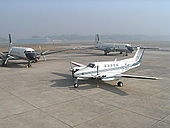 | Utility aircraft | B200 | 2 | As of 2009.[10] | |
| Embraer 135 | 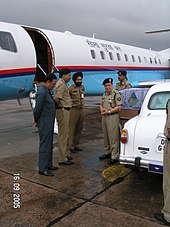 | VIP transport | Embraer-135 J | 2 | As of 2009.[11] | |
| Helicopters (16) | ||||||
| HAL Dhruv |  | Utility helicopter | 8 | As of 2009.[10] | ||
| Mi-17 | 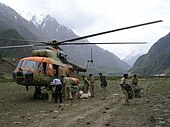 | Transport helicopter | Mi-17 Mi-17V5 | 6 2 | As of 2009.[10] As of 2014.[12] | |
Elite Commando Force of Border Security Force[edit]
Creek Crocodile Commando are the elite commando force of BSF. It is Rann of Kutch (an extensive salt marsh of western India and southeast Pakistan between the Gulf of Kutch and the Indus River delta. It was the scene of major border disputes in 1965 and 1971). Creek (Gujarat): In order to thwart landing of terrorists through the sea route, BSF has formed its first commando unit—Creek Crocodiles—to man the hostile creek area where India shares a border with Pakistan.
Creeks are a very hostile terrain, constituting numerous raised grounds having mangroves and a network of water channels which are quite shallow where all movements are tide dependent.
Creek Crocodiles are trained to thwart any evil designs from across the border, BSF commandant Pushpendra Singh Rathore, who had created and trained the commando unit at Koteshwar outpost of BSF, said.
"We have kept three things in mind while selecting cadets for the commando including swimming and marine diving performance, firing abilities and endurance to work in the rough creek,".[citation needed]
The Crocodile units have 42 commandos at present[when?] and they are undergoing vigorous training, he said.
Mine Protected Vehicles[edit]
According to the senior BSF officer, some MPVs have already been introduced in a number of BSF units along the border and more MPVs to be added in the coming years.[13]
Controversies with Bangladesh[edit]
| The neutrality of this article is disputed. (January 2012) |
| This section may require cleanup to meet Wikipedia's quality standards. (January 2012) |
According to the Bangladeshi government, 136 civilians were killed and a further 170 others suffered injury's in 2009. The Indian government has said that 67 were killed and 80 injured in 2009.[14] The Bangladesh government and Bangladeshi organisations protest heavily against these alleged killings. Media reports claim that in August 2008, Indian BSF officials admitted that they killed 59 illegals (34 Bangladeshis, 21 Indians, rest unidentified) who were trying to cross the border illegally during the prior six months.[15] Indian media claimed that, in 2001, Bangladeshi Border Force kidnapped and murdered 16 BSF personnel because they chased some Bangladeshi goons back to Bangladesh. Since then, the BSF has been compelled to acts tough against Bangladeshi illegals[16]
In July 2009 Channel 4 News reported that apparently "hundreds" of Bangladeshis and Indians are indiscriminately killed by the BSF along the Indo-Bangladeshi Barrier. The BSF claims that the barrier's main purpose is to check illegal immigration to India, and prevent cross-border terrorism from Islamists.[17]
Bangladeshi media accused the BSF of abducting 5 Bangladeshi children, aged between 8 and 15, from the Haripur Upazila in Thakurgaon District of Bangladesh, in 2010. The children were setting fishing nets near the border.[18]
In 2010, Human Rights Watch (HRW) issued an 81-page report which alleged "over 900 of abuses by the BSF" in the first decade of the 21st century. The report was compiled from interviews with victims of BSF shootings, witnesses and members of the BSF and itsBangladeshi counterpart. According to HRW, while most of them were killed when they crossed into Indian territory for indulging in cattle raiding or other smuggling activities.[19]
In February 2012, the BSF website was hacked by Bangladeshi hackers in retaliation. The hackers later shared the news in the internet and also in the other social sites where they claimed to have defaced the sites asking the BSF to stop killing Bangladeshis at border. The site became normal sometime on 15 February 2012.[20][21]
Planning and development[edit]
| This section is empty. You can help by adding to it. (January 2013) |
Facing difficulty in guarding riverine sections of Indo-Pak border, the BSF has started installing Farheen LASER walls to fill the gaps which saw several breach by militants from across the border.[24]
Criticism[edit]
In 2010, some Canadian visa officials rejected the immigration application of a retired BSF soldier Moninder Singh Pandher, terming BSF a "notoriously violent paramilitary unit engaged in systematic attacks on civilians and responsible for torturing suspected criminals". This accusation against one of India's elite Central Police force did not go down well with the Indian government. The Indian External Affairs Ministry was asked by the Home minister to take up the issue with Canada.[25] The Home ministry of India, as well as the Indian public in general and several of India's political parties, have expressed outrage at this attack and have called Canada's actions discriminatory and spurious, and their charges against the BSF as baseless and unproven. The Indian government has threatened diplomatic retaliation unless they withdraw their allegations. The Canadian government did not respond immediately.[26] It was speculated that diplomatic retaliation from India will consist of banning Canadians going to participate the War in Afghanistan if they are doing so through India. Public outrage in India prompted Canadian authorities to express "great respect for India's armed forces and related institutions".[27] Subsequently, India's Ministry of External Affairs summoned Canadian High Commissioner Joseph Caron and demanded that "the blatant discrimination against Indian security agencies" cease.[28] India's Minister of External Affairs, SM Krishna, condemned Canada's actions and has expressed pride in the accomplishments of the BSF.[29]
Following complaints made by the Indian government and criticism of Canada's actions against India, the Harper government retracted their earlier accusations against BSF security officials. Canada's Minister of Citizenship and Immigration, Jason Kenney, Termed as "unfortunate" the incidents involving use of "foul language by the Canadian High Commission in visa rejection letters to some individuals", Kenney said, "This language, or the inaccurate impression it has created, in no way reflects the policy or position of theGovernment of Canada."[30]
See also[edit]
Border Security Force
Adwww.sulekha.com/MumbaiList of Top Security Service Providers in Mumbai. Get Quotes!
Search Results
Power of Indian Border Security Force Part One - YouTube
https://www.youtube.com/watch?v=D_4TyUy8mWM
Apr 24, 2013 - Uploaded by mukesh saini
For more updates on defence and Land Forces just visit http://firepower.co.in http:Border Security Force ( BSF ) - Duty unto Death - YouTube
https://www.youtube.com/watch?v=B6Ecr9OzXwg
Aug 15, 2011 - Uploaded by IndiaDefence
With a strength of 240000 personnel in 186 battalions, including women battalions, BSF is one of the world's ...Indian Border Security Force don't care International Border ...
https://www.youtube.com/watch?v=zIH0YNLV0vc
Jan 11, 2013 - Uploaded by HD World
Indian Military Force Kill Innocent People in Border Indian Terrorist Force BSF Indian Military Force Killed in ...BSF Border Security Force | India - YouTube
https://www.youtube.com/watch?v=fNCFCEMro90
Apr 11, 2009 - Uploaded by Calm Water
Protectors of the borders of India. http://bsf.nic.in/ Indian Army.Border security force training - YouTube
https://www.youtube.com/watch?v=w_73GxTyAdk
Mar 5, 2012 - Uploaded by chavanmanjunath5
Border security force training. ... Special Report - BSF in Chhattisgarh: Life on the Edge (Part 2/2) - Duration ...Border Security Force & Pakistan Rangers - YouTube
https://www.youtube.com/watch?v=7wndkGMPi2Y
Jul 16, 2012 - Uploaded by NomadicSamuel
The following is a 'best of' video from the India & Pakistan border closing ceremony in Wagah. One can ...Pakistani rangers kill Border Security Force soldier - YouTube
https://www.youtube.com/watch?v=p_w0uoq00j0
Jul 18, 2014 - Uploaded by newsfirstonline
Pakistani rangers kill Border Security Force soldier.India's Border Security Force (BSF) in Action - YouTube
https://www.youtube.com/watch?v=en08El6FOEw
May 30, 2009 - Uploaded by kashsoldier
BSF. ... India's Border Security Force (BSF) in Action .... Can yoyu tell me which aircraft at 02:16 is being ...Border Security Force (BSF) camp - Assam, India - YouTube
https://www.youtube.com/watch?v=qCtcFz_cqvM
May 28, 2014 - Uploaded by WildFilmsIndia
View of Border Security Force (BSF) camp in Assam, India. TheBorder Security Force (BSF) is a Border ...BSF TRAINING - YouTube
https://www.youtube.com/watch?v=VxcfrGUxKrU
Nov 12, 2012 - Uploaded by simoncha100
BSF TRAINING ... 49th Raising Day Parade of Border Security Force (BSF) | December 1, 2014 - Duration ...
Stay up to date on results for border security force.
Create alertSearch Results
Border Security Force
www.bsf.nic.in/
Describes its purpose, careers, training and welfare provision.
Border Security Force - Wikipedia, the free encyclopedia
https://en.wikipedia.org/wiki/Border_Security_Force
The Border Security Force (BSF) (Hindi: सीमा सुरक्षा बल) is the primary Border police force of India. It is one of the five Central Armed Police Forces of the ...
General nature: Federal law enforcement; ...
Formed: 1 December, 1965
Headquarters: New Delhi, India
Motto: जीवन पर्यंत कतृव्यं
Border Security Force - Home
bsf.gov.in/
The Border Security Force (BSF) is a Border Guarding Force of India. Established on December 1, 1965, it is a paramilitary force charged with guarding India's ...(BSF) Recruitment - Sarkari Naukri World
www.sarkarinaukrisarch.in/bsf-recruitment/
2 days ago - Border Security Force (BSF) Recruitment – 05 PGT (Teacher) Vacancy ... BSF Recruitment – 02 Adm Officer cum Account Officer & Lower ...
In the news
Border Security Force differs on Pakistan terrorists entry, says no evidence found
Economic Times - 15 hours ago
50 years on guard: Border Security Force (BSF) celebrates its formation day on December 1 : Listicles: Microfacts
More news for border security force
India Today - 8 hours ago
As Border Security Force celebrates its 50th Raising Day ...
https://plus.google.com/.../posts/A99FeJnaCEf
12 hours ago - As Border Security Force celebrates its 50th Raising Day today, a salute to the personnel who protect our bordersBorder Security Force - NDTV.com
www.ndtv.com › Topic
Find Border Security Force Latest News, Videos & Pictures on Border Security Forceand see latest updates, news, information from NDTV.COM. Explore moreHow good is the Indian Border Security Force (BSF)? - Quora
https://www.quora.com/.../How-good-is-the-Indian-Border-Security-Force-...
The BSF currently stands as the world's largest border guarding force. BSF has been termed as the First Wall of Defense of Indian Territories. I do agree wit...Border Security Force (BSF) announces recruitment to 136 ...
indiatoday.intoday.in/.../story/border-security-force-bsf.../449690.html
Jul 7, 2015 - Border Security Force (BSF), Ministry of Home Affairs has notified recruitment 2015.Border Security Force
Adwww.sulekha.com/MumbaiList of Top Security Service Providers in Mumbai. Get Quotes!Sulekha.com has 1,714 followers on Google+
Searches related to border security force
Kharghar, Navi Mumbai, Maharashtra - From your Internet address - Use precise location

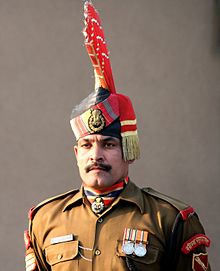

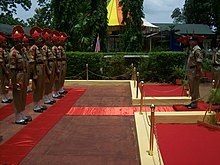



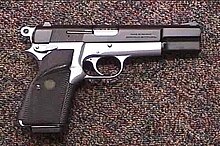








Nice Post,Keep Updating Like This.
ReplyDeleteCDS Exam
CDS Exam Syllabus
CDS Exam Pattern
Nice Post,Keep Updating Like This.
ReplyDeleteDiet Plan For Women
Nice Post,Keep Updating Like This.
ReplyDeleteMarch 2017 Calendar Templates
March 2017 Printable Calendar
March Calendar With 2017 Holidays
FCI Odisha Recruitment
ReplyDeleteGovt Jobs
Best music player apps
Basic Electronics
Haryana Police Recruitment 2018
ReplyDeleteHaryana Police Vacancy 2018 Notification
Haryana Police Admit Card